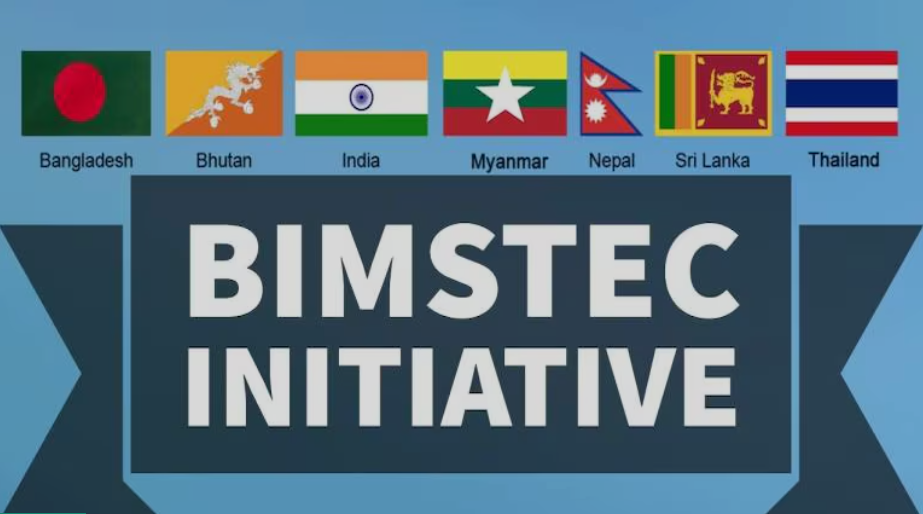Revival of Free Trade Agreement (FTA) Talks with BIMSTEC (GS Paper 2, IR)

Context
- The Bay of Bengal Initiative for Multi-Sectoral Technical and Economic Cooperation (BIMSTEC) held a recent business summit organized by the Confederation of Indian Industries (CII) and the Ministry of External Affairs.
- The summit highlighted the need for renewed efforts to finalize the Free Trade Agreement (FTA) that has faced significant delays.
Background
Negotiation History:
- Initiation: BIMSTEC members began negotiations for a Free Trade Agreement in 2004. Since then, 22 rounds of talks have been held, with the most recent round occurring in 2018.
- Framework Agreement: In 2004, BIMSTEC concluded the Framework Agreement on the BIMSTEC Free Trade Area. This agreement aimed to streamline trade and investment by simplifying customs procedures and developing mutual recognition arrangements for trade and investment facilitation.
About BIMSTEC
Establishment:
- Year: BIMSTEC was established in 1997 with the signing of the Bangkok Declaration.
- Permanent Secretariat: Located in Dhaka, Bangladesh.
- Member Countries: The organization includes Bangladesh, Bhutan, Sri Lanka, Nepal, Thailand, Myanmar, and India.
Significance:
- Population: The BIMSTEC region encompasses 22% of the world's population.
- GDP: The combined GDP of BIMSTEC countries is approximately $3.6 trillion, highlighting the economic significance of the region.
India’s Trade with BIMSTEC
- Total Trade (2023-24): India's trade with BIMSTEC countries reached $44.32 billion.
- Thailand: India’s largest trading partner in the bloc, with exports amounting to $5.04 billion and imports totaling $9.91 billion, resulting in a trade deficit of $4.87 billion.
- Bangladesh: India had exports of $11.06 billion and imports of $1.84 billion, resulting in a trade surplus of $9.22 billion.
What Is a Free Trade Agreement (FTA)?
- Definition: A Free Trade Agreement is a pact between two or more countries aimed at reducing or eliminating barriers to trade, such as tariffs, quotas, and subsidies. This facilitates easier and more cost-effective exchange of goods and services across borders.
- India’s FTAs: India has entered into 13 Regional Trade Agreements (RTAs) or FTAs, including agreements with Japan, South Korea, ASEAN countries, Mauritius, UAE, and Australia.
Benefits of the BIMSTEC Free Trade Agreement
Increased Trade Flows:
- Reduction in Barriers: The FTA would lower tariffs and non-tariff barriers, leading to an increase in trade volume among BIMSTEC member countries.
- Enhanced Market Access: Easier access to each other’s markets would promote trade and economic activity within the region.
Economic Integration:
- Deeper Ties: The FTA would promote closer economic integration among BIMSTEC countries, fostering stronger economic ties and regional stability.
- Economic Stability: Improved trade relations could contribute to greater economic stability and resilience in the region.
Market Access for Smaller Countries:
- Integration: Smaller member states like Bhutan and Nepal would benefit from better integration into the global economy through enhanced access to larger markets within BIMSTEC.
Attraction of Foreign Direct Investment (FDI):
- Investment Opportunities: A more integrated market with reduced trade barriers would be more attractive to foreign investors, potentially increasing FDI inflows into the region.
Challenges and Recommendations
Current Challenges:
- Delayed Progress: The FTA negotiations have been stalled, and no new developments have occurred since 2018.
- Diverse Priorities: Member countries have varying priorities and economic interests, complicating the negotiation process.
- Implementation Issues: Existing agreements and frameworks have not been effectively implemented, leading to inefficiencies and delays.
Recommendations for Revival:
- Enhanced Engagement: Governments and business communities should collaborate more effectively to explore new pathways for advancing the FTA. This includes addressing varying priorities and finding common ground.
- Local Currency Payments: Encouraging the use of local currencies for trade transactions within the region could simplify financial operations and reduce costs.
- Customs Integration: Improving customs procedures and integrating border controls through computerization and faster clearance processes would enhance trade efficiency.
- Innovative Solutions: Developing innovative solutions to address existing challenges and barriers will be crucial for progressing with the FTA.
Way Forward
- To revive and advance the BIMSTEC Free Trade Agreement, concerted efforts from both governments and the business community are essential.
- This involves realigning priorities, addressing implementation challenges, and finding practical solutions to facilitate trade and investment.
- Strengthening regional cooperation, improving customs procedures, and fostering an environment conducive to trade will be key to achieving the goals of the BIMSTEC FTA.


